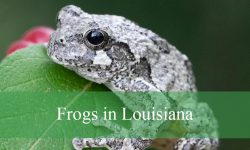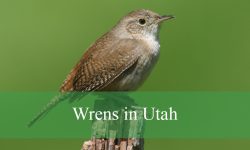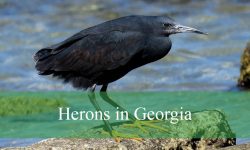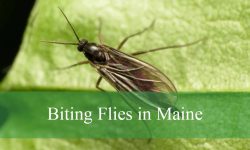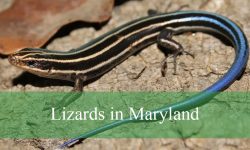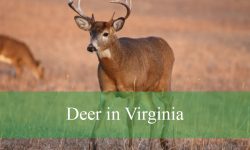Texas hosts an incredible diversity of warblers, attracting birdwatchers from across the country. These colorful songbirds enliven forests, wetlands, and urban parks during migration seasons.
Many warbler species are migratory, appearing mainly in spring and fall, each with unique songs, plumage patterns, and behaviors. Spotting them can be both challenging and rewarding for observers of all skill levels.
This guide highlights 42 types of warblers found in Texas, complete with images, identification tips, and habitat information. It serves as a comprehensive resource for anyone looking to explore these vibrant birds.
Different Types of Warblers Found in Texas
Yellow-rumped Warbler (Setophaga coronata)
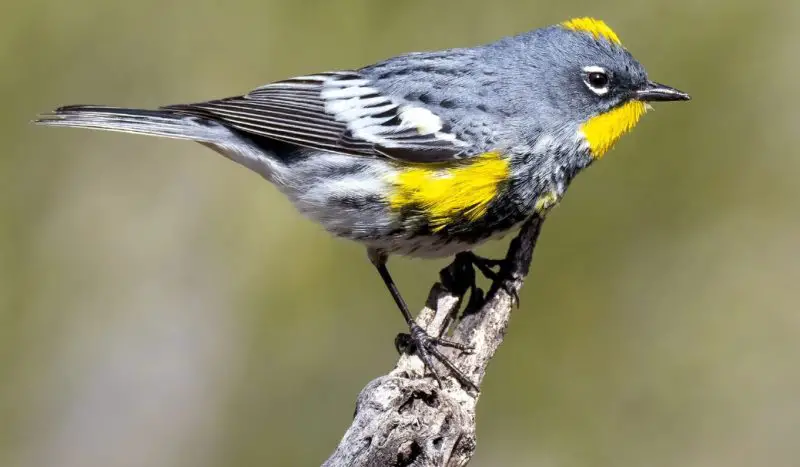
The Yellow-rumped Warbler is one of the most common and widespread warblers in Texas, especially noticeable during migration and in winter. Measuring about 5 to 6 inches in length with a wingspan of 9 to 10 inches, it has a distinctive yellow patch on the rump, which gives the bird its name. Both males and females share this feature, though males are more boldly patterned with streaked gray, black, and white plumage, while females appear slightly duller.
This species is highly adaptable and feeds on insects, berries, and seeds. In winter, Texas birdwatchers often spot them foraging in open woodlands, parks, and even suburban areas, where they dart among trees and shrubs in search of food. They are agile fliers, often hovering momentarily to glean insects from leaves or catching them in mid-air.
In Texas, the Yellow-rumped Warbler is a winter resident and a migrant, with large numbers arriving from northern breeding grounds. Their adaptability to different habitats, from pine forests to urban backyards, makes them one of the easiest warblers to observe in the state. Their sharp “check” calls are a common sound in wooded areas during cooler months.
Orange-crowned Warbler (Leiothlypis celata)
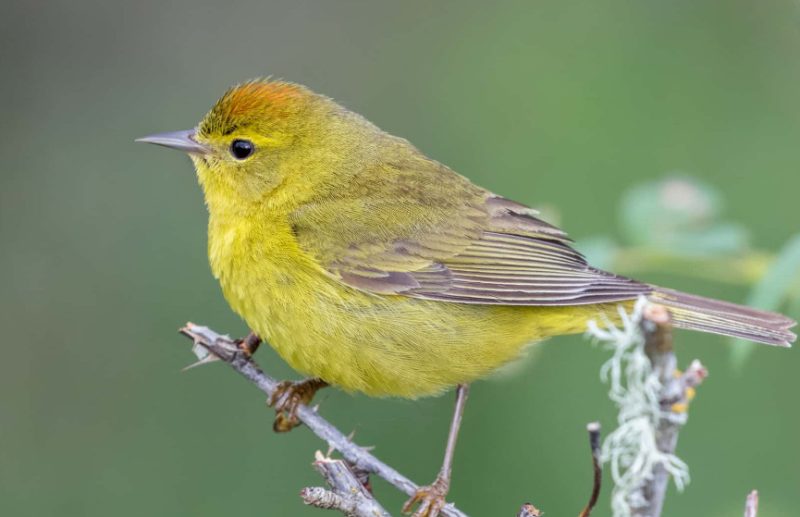
The Orange-crowned Warbler is a small, olive-green warbler that lacks bold markings, making it more difficult to identify compared to other species. Adults measure around 4.7 to 5.5 inches long, with a wingspan close to 7.5 inches. The bird’s namesake orange crown is rarely visible, only occasionally seen when the feathers are raised. Instead, observers usually note its plain yellow-green plumage and faint streaking underneath.
These warblers forage actively, often low in shrubs and brush, where they search for insects, caterpillars, and spiders. They also consume nectar and berries, making them frequent visitors to hummingbird feeders in Texas gardens during migration. Their behavior is restless, with constant hopping and flicking of the tail as they search for food.
In Texas, Orange-crowned Warblers are most commonly seen during migration and in the winter months. They occupy a variety of habitats including woodland edges, thickets, and suburban landscapes. Because they blend in so well with their surroundings, birdwatchers often detect them by their sharp, thin “chip” call before actually seeing the bird.
Nashville Warbler (Leiothlypis ruficapilla)
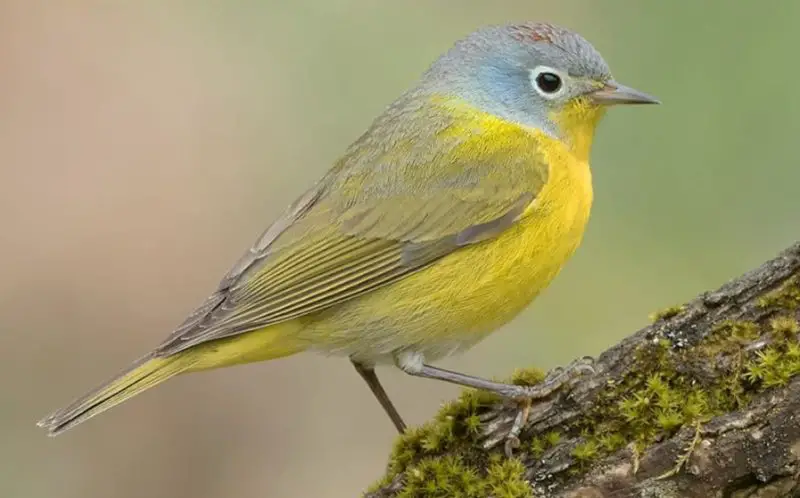
The Nashville Warbler is a small, lively bird that measures around 4.3 to 5 inches in length. It is recognized by its gray head, white eye-ring, and bright yellow underparts. Adults may also show a faint chestnut patch on the crown, though this is not always visible. Their plain olive back contrasts with their colorful underside, making them a delightful find for birdwatchers in Texas.
This warbler feeds primarily on insects such as beetles, caterpillars, and flies. It actively gleans insects from foliage and frequently hovers to pick prey from the undersides of leaves. During migration through Texas, they can often be spotted in mixed-species foraging flocks, moving quickly through trees and shrubs.
In Texas, Nashville Warblers appear primarily during spring and fall migration as they travel between their northern breeding grounds and wintering areas in Mexico and Central America. They favor woodland edges, riparian corridors, and brushy habitats, where their high-pitched “tsip” call often alerts birders to their presence before they are seen.
Tennessee Warbler (Leiothlypis peregrina)
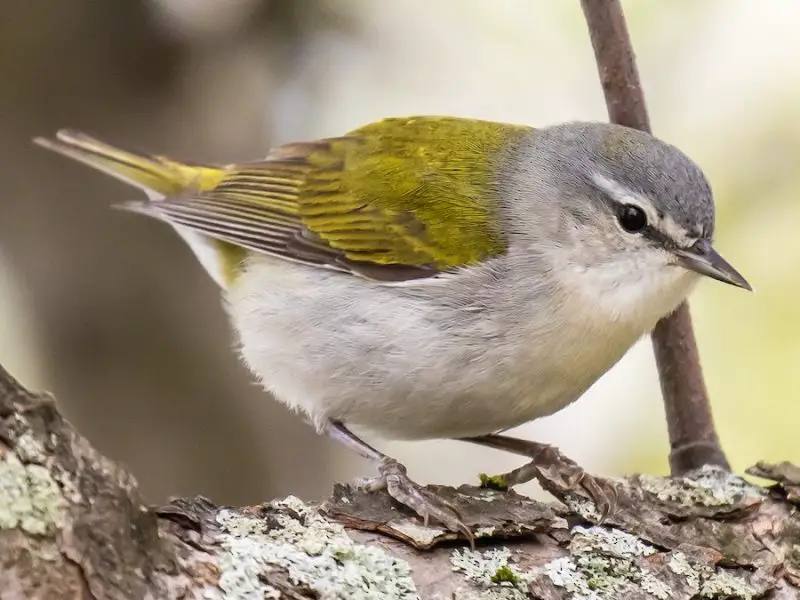
The Tennessee Warbler is a small warbler measuring about 4.5 to 5 inches long with a wingspan around 7.5 inches. Breeding males are characterized by a gray head, white underparts, and greenish back, while females and nonbreeding individuals are generally duller, with a yellowish tinge on their underside. They lack wing bars, giving them a plain overall look compared to other warblers.
Feeding habits are specialized, as Tennessee Warblers consume large numbers of caterpillars, particularly spruce budworms on their northern breeding grounds. In Texas, they shift their diet to include other insects and small fruits while migrating. They forage actively among tree canopies, often hanging upside down to pluck insects from leaves.
This species is seen in Texas primarily during spring and fall migration. They prefer forest edges, parks, and woodland habitats while passing through the state. Their short, sharp “tik” calls often give away their presence, though their active foraging high in the trees can make them difficult to spot.
Black-and-white Warbler (Mniotilta varia)
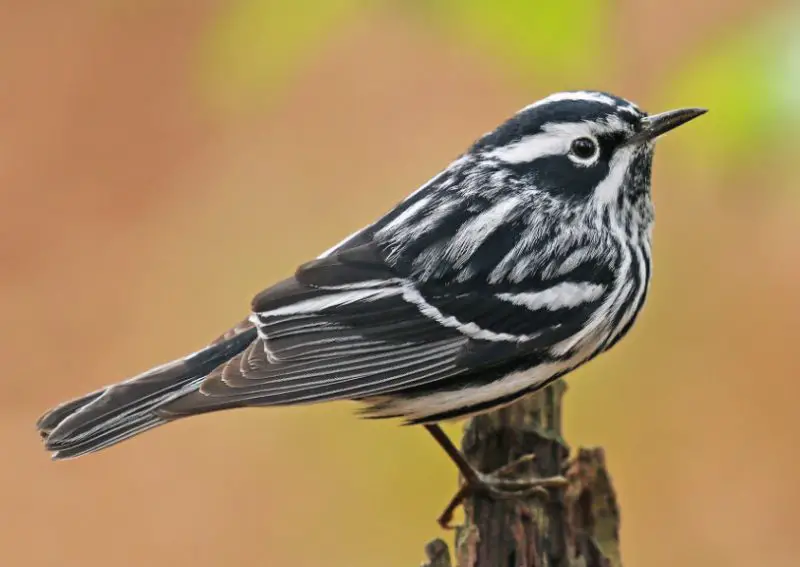
The Black-and-white Warbler is a distinctive species easily recognized by its striking black-and-white striped plumage. Adults measure about 4.3 to 5.1 inches in length with a wingspan of 7 to 8 inches. Unlike most warblers, they are not brightly colored, but their bold streaked pattern and habit of creeping along tree trunks and branches set them apart.
Behaviorally, Black-and-white Warblers are unique in that they forage like nuthatches, moving headfirst down tree trunks while probing bark crevices for insects and spiders. They are active and acrobatic feeders, often working their way methodically through wooded areas in search of prey. Their thin, high-pitched song and squeaky calls are characteristic during migration.
In Texas, they occur mainly as migrants, with some overwintering in the southern parts of the state. They frequent forests, woodlands, and riparian zones, often observed in both deciduous and mixed pine habitats. Their unusual foraging behavior makes them easier to identify in the field compared to many other warblers that forage higher in the canopy.
Northern Parula (Setophaga americana)
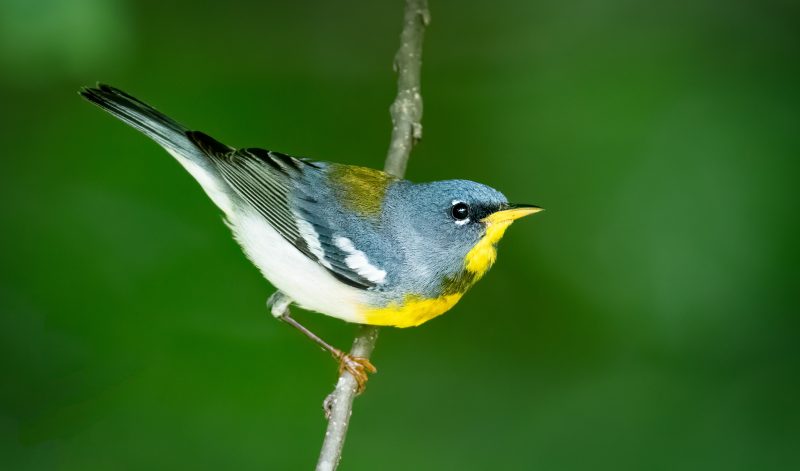
The Northern Parula is a small, colorful warbler that measures about 4.3 inches in length with a wingspan of around 6.5 inches. Males are especially striking, with bluish-gray upperparts, a bright yellow throat and chest, and a distinctive chestnut and black band across the breast. Females and immatures are paler but still share the same general color pattern. Their broken white eye-ring helps birdwatchers identify them in the field.
This warbler is active and energetic, often seen flitting among the upper branches of trees in search of insects, caterpillars, and spiders. They frequently forage by gleaning prey from leaves and occasionally hover to snatch food from foliage. Their buzzy, rising trill-like song is a common clue to their presence during migration through Texas.
In Texas, Northern Parulas are most often encountered during migration, though some breed in the eastern parts of the state, particularly in moist forests with Spanish moss or beard lichen. They prefer riparian woodlands and bottomland habitats, making them a rewarding find for birders exploring rivers and swamps.
American Redstart (Setophaga ruticilla)
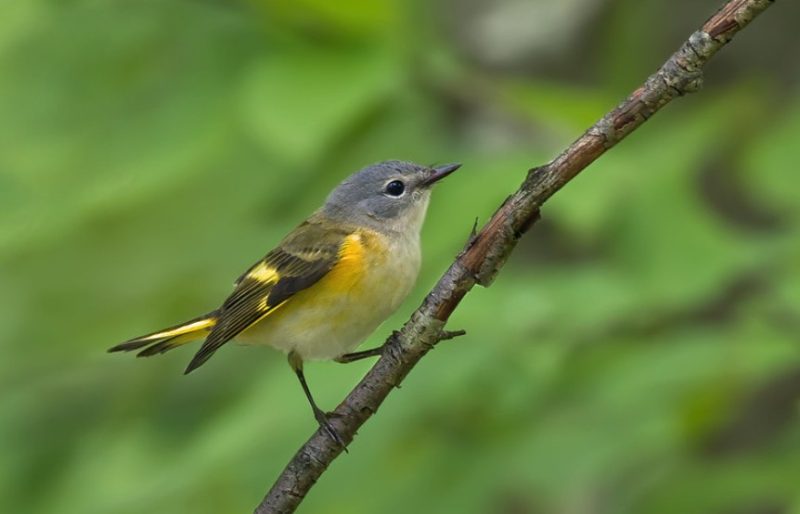
The American Redstart is a medium-sized warbler, averaging 4.7 to 5.5 inches long with a wingspan of about 7 to 9 inches. Males are easily identified by their striking black plumage with bright orange patches on the wings, tail, and sides, creating a dramatic contrast. Females and immature males are more subdued, showing gray or olive coloring with yellow patches instead of orange.
This species is highly active and acrobatic, constantly flicking its tail and wings to startle insects into flight, which it then catches mid-air. American Redstarts are known for their bold foraging techniques and lively movements, making them one of the most dynamic warblers to observe in Texas. Their musical, high-pitched series of notes often adds to their lively presence.
In Texas, American Redstarts are most often seen during spring and fall migration, passing through wooded habitats, thickets, and parks. Some linger in the southern parts of the state during winter. Their preference for dense shrubs and edges makes them easier to spot at lower levels compared to many canopy-dwelling warblers.
Yellow Warbler (Setophaga petechia)
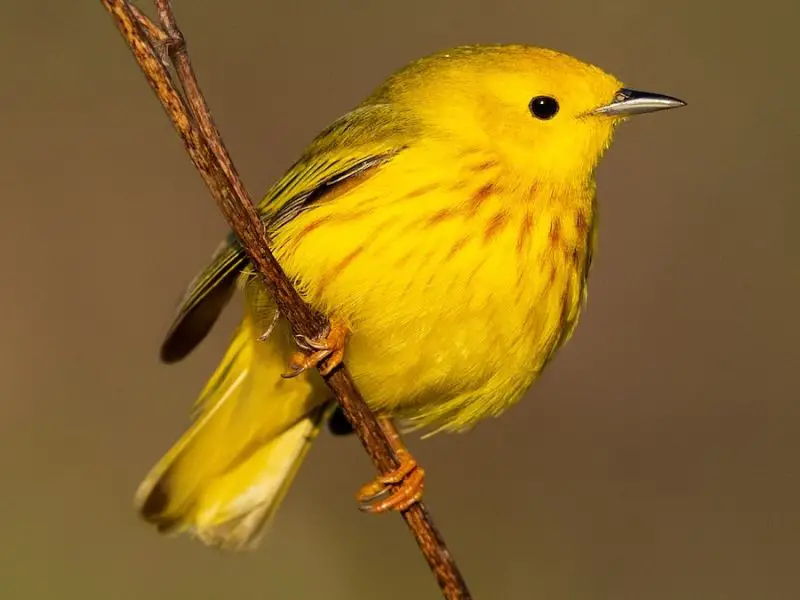
The Yellow Warbler is a small, bright bird measuring 4.7 to 5.1 inches long with a wingspan of about 7.5 inches. True to its name, it is mostly yellow, with males displaying reddish streaks across the breast that add extra color. Females and immatures are slightly duller, but their overall yellow tone makes them one of the easiest warblers to recognize.
This species feeds primarily on insects such as caterpillars, beetles, and midges. It actively gleans prey from leaves and often hovers to pick insects from foliage. The Yellow Warbler’s sweet, musical song, often described as “sweet-sweet-sweet, I’m so sweet,” is commonly heard during migration and in breeding areas.
In Texas, Yellow Warblers are frequent migrants, particularly in spring and fall. They can be found in a variety of habitats including riparian corridors, open woodlands, and brushy areas. Some breed in limited parts of the state, especially in wetter regions with willow and cottonwood trees, where they prefer dense shrubs near water.
Pine Warbler (Setophaga pinus)
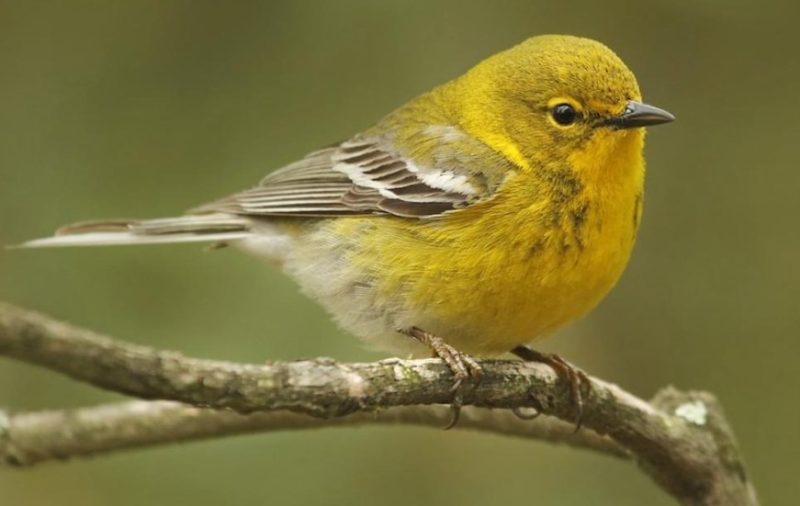
The Pine Warbler is a medium-sized warbler, averaging 5.1 to 5.5 inches in length with a wingspan of 7.5 to 9 inches. True to its name, it is strongly associated with pine forests. Males are olive above with yellow throats and breasts, while females and immature birds tend to be paler with grayish tones. They often show faint wing bars and a sturdy, short bill.
Unlike many warblers, Pine Warblers often feed on seeds in addition to insects. During the cooler months, they readily visit bird feeders in Texas, where they consume millet and sunflower seeds. They also forage in the canopy, probing pine needles for insects, caterpillars, and spiders. Their musical trill resembles that of a Chipping Sparrow but is slightly slower and sweeter.
In Texas, Pine Warblers are resident in the eastern pine forests, particularly in the Pineywoods region. They can be seen year-round in these habitats, making them one of the more reliable warblers to spot in the state. Their preference for pine-dominated landscapes sets them apart from many other species that migrate through Texas only seasonally.
Palm Warbler (Setophaga palmarum)
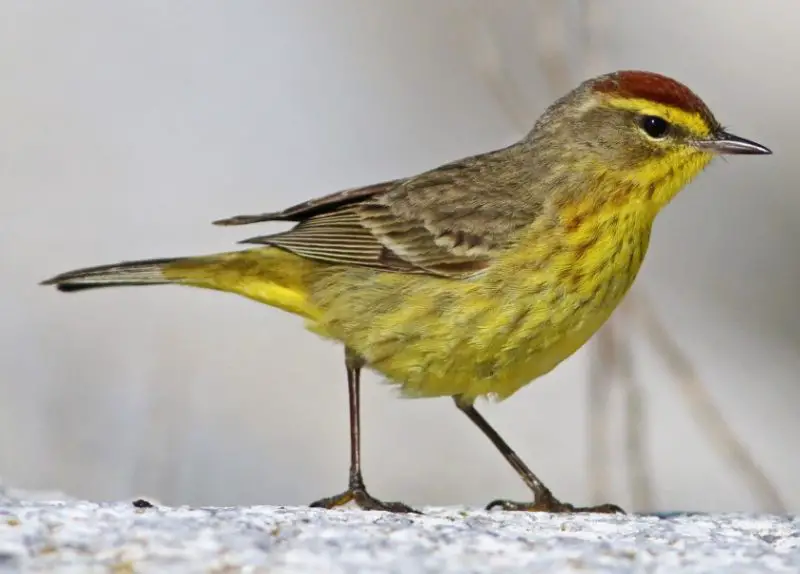
The Palm Warbler is a distinctive warbler, measuring 4.7 to 5.5 inches long with a wingspan of around 8 inches. Unlike many warblers that prefer treetops, Palm Warblers are often seen on the ground or in low shrubs. They are recognized by their brown-olive plumage, yellow underparts, and a chestnut cap, which is most prominent in breeding males. A constant tail-bobbing habit is their most distinctive field mark.
Palm Warblers feed mostly on insects, which they glean from the ground or low vegetation. During migration and winter, they also eat berries and seeds. Their foraging style, which includes frequent ground-hopping and tail pumping, makes them easier to identify even from a distance.
In Texas, Palm Warblers are considered uncommon but regular during migration and winter, especially along the Gulf Coast and in open fields with scattered shrubs. They are more terrestrial than many other warblers, often seen in grassy habitats, marsh edges, and coastal prairies, where their tail-wagging behavior quickly draws attention.
Prairie Warbler (Setophaga discolor)
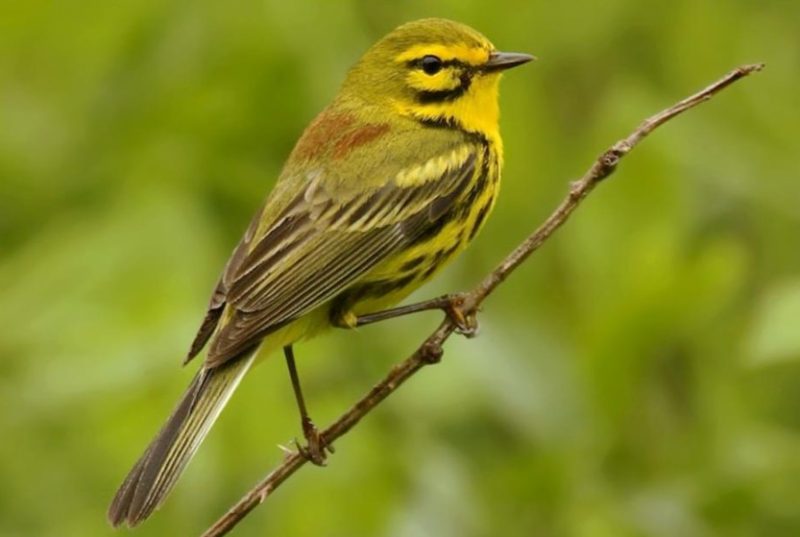
The Prairie Warbler is a small, slender songbird, about 4.3 to 5.1 inches long with a wingspan of 7 inches. It is easily recognized by its bright yellow underparts, streaked sides, olive upperparts, and a distinctive black line through the eye with additional facial markings. Males are more boldly marked than females, making them stand out in the field.
This warbler is known for its energetic behavior, often flitting between shrubs and small trees while constantly flicking its tail. It feeds mainly on insects, spiders, and small caterpillars, foraging low in brushy habitats. Its rising buzzy song, sounding like a series of accelerating notes, is often the first sign of its presence.
In Texas, Prairie Warblers are mostly migrants, passing through in spring and fall. They prefer shrubby fields, regenerating forests, and thickets during migration. While uncommon compared to other warblers, birders with a keen ear can detect them in dense scrubby habitats, especially in the eastern part of the state.
Bay-breasted Warbler (Setophaga castanea)
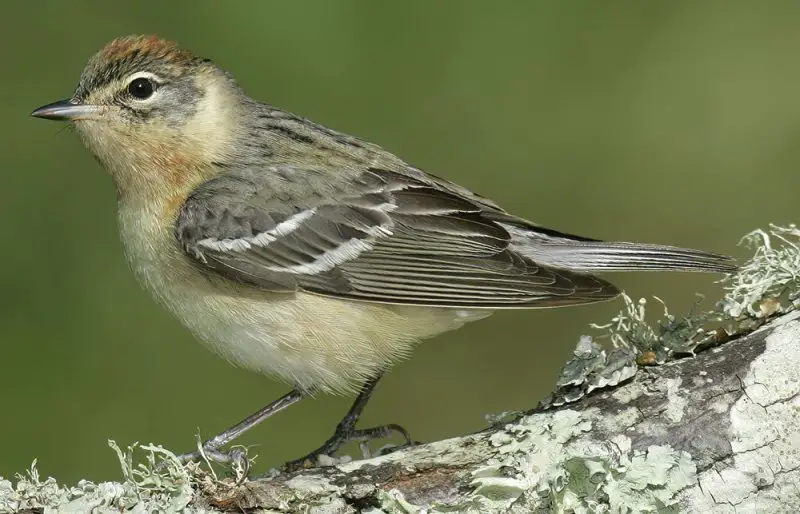
The Bay-breasted Warbler is a medium-sized warbler measuring 5.1 to 5.5 inches in length with a wingspan close to 8.5 inches. Breeding males are striking, with chestnut-colored throats and flanks, black faces, and olive backs, making them one of the more colorful warblers. Females and nonbreeding birds are duller, showing more subdued olive-gray plumage with faint streaking.
This species feeds heavily on insects, particularly spruce budworms in its northern breeding range. In Texas during migration, they switch to a mixed diet of insects and berries. They forage mostly in the middle to upper canopy, moving methodically among branches in search of prey.
In Texas, Bay-breasted Warblers are seen during spring and fall migration, though they are considered uncommon. Birdwatchers often encounter them in wooded habitats, especially along the Gulf Coast where many migrants stop to rest and refuel. Their quiet behavior and canopy preference make them a challenge to spot.
Blackburnian Warbler (Setophaga fusca)
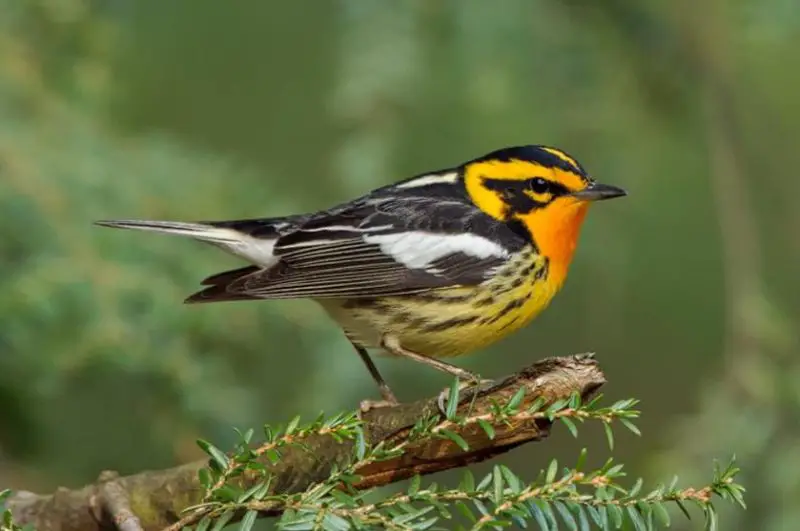
The Blackburnian Warbler is a small, vibrant bird measuring about 4.7 to 5.1 inches long with a wingspan of 8 inches. Breeding males are unmistakable with their fiery orange throat and face, contrasted with black upperparts and bold white wing patches. Females and immature birds are paler, showing yellowish throats instead of the vivid orange.
Known for its graceful foraging style, the Blackburnian Warbler often gleans insects from the tops of tall trees, especially conifers. They primarily eat caterpillars, beetles, and other small invertebrates. Their high-pitched, thin song, often described as a series of sharp notes ending in a squeaky trill, carries well through forests.
In Texas, Blackburnian Warblers occur mainly during migration, particularly in spring and fall. They are often spotted in wooded parks, forest edges, and coastal woodlands. Though not common, their brilliant coloration makes them one of the most rewarding warblers to observe in the state.
Black-throated Blue Warbler (Setophaga caerulescens)
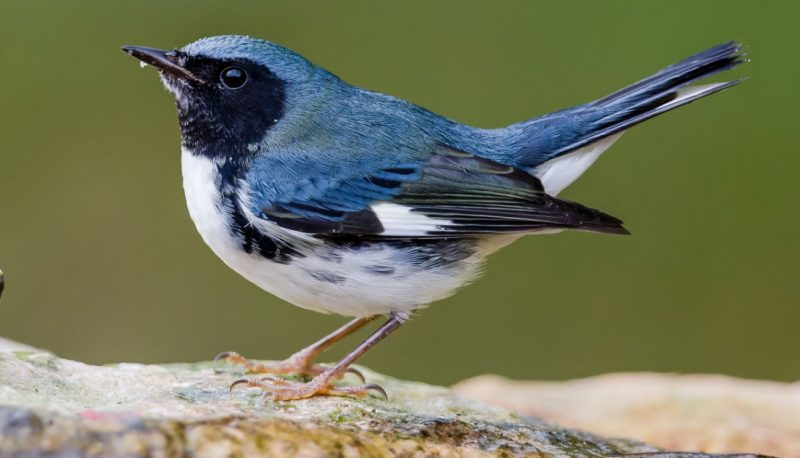
The Black-throated Blue Warbler is a medium-sized warbler, about 5 inches in length with a wingspan of 7.5 inches. Males are distinctive with deep blue upperparts, a black face and throat, and white underparts with a small white patch on the wing. Females are very different in appearance, being olive-brown with a pale eyebrow and the same white wing spot.
This species feeds mostly on insects such as caterpillars and flies, often gleaning them from leaves in the understory. They also eat small berries during migration. Unlike some warblers that stay high in the canopy, Black-throated Blue Warblers often forage at mid-levels, making them more accessible to birdwatchers.
In Texas, this warbler is primarily a migrant, seen during spring and fall as it travels between its breeding grounds in the northeastern U.S. and wintering areas in the Caribbean. They prefer wooded habitats, including mature forests and parks, where their soft, buzzy song may be heard during migration.
Black-throated Green Warbler (Setophaga virens)
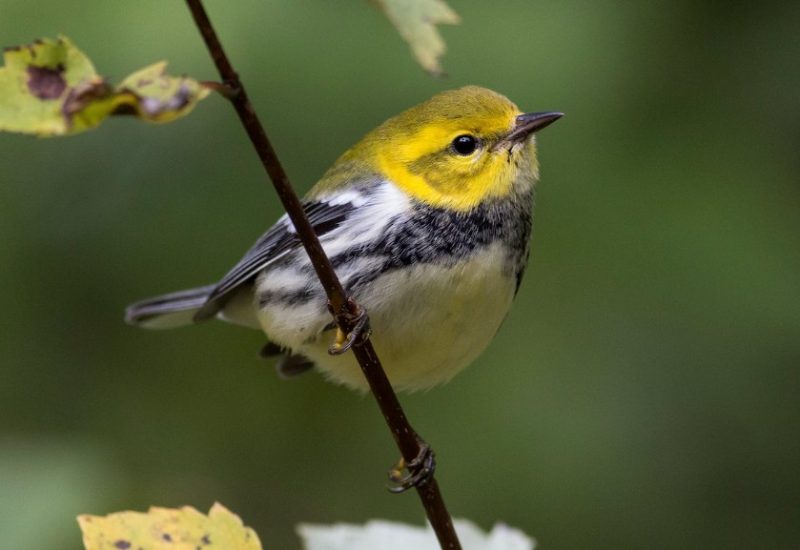
The Black-throated Green Warbler is a small warbler measuring 4.3 to 5.1 inches in length with a wingspan of about 7.5 inches. Males are easily identified by their bright yellow faces, olive-green backs, and bold black throats extending onto the breast. Females and immatures are duller but still show the yellow face and greenish upperparts.
This warbler actively forages in trees, searching for insects, spiders, and caterpillars. They often move methodically through branches, occasionally hanging upside down to glean prey. Their distinctive song, often described as “trees, trees, whispering trees,” is a common sound on their breeding grounds but can also be heard during migration.
In Texas, Black-throated Green Warblers are regular migrants in both spring and fall. They frequent forests, parks, and riparian corridors, often joining mixed flocks of other warblers. Though small, their bright yellow face and contrasting throat make them relatively easy to identify compared to other species.
Chestnut-sided Warbler (Setophaga pensylvanica)

The Chestnut-sided Warbler is a striking bird measuring about 4.7 to 5.1 inches long with a wingspan of 7.5 inches. Breeding males are easily recognized by their bright yellow crown, white underparts, and bold chestnut streaks running along the sides. Females and immatures are less colorful, often showing greenish backs and faint streaking, but still retain the overall pattern.
This warbler is very active, frequently flicking its wings as it forages for insects and caterpillars in shrubs and small trees. It is known for its buzzy, cheerful song, which birders often describe as “pleased, pleased, pleased to meetcha.” Its bold movements and vocalizations make it easier to detect compared to some of the more secretive warblers.
In Texas, Chestnut-sided Warblers appear mainly during spring and fall migration. They prefer shrubby habitats, woodland edges, and regenerating forests while passing through. Though not among the most common migrants in the state, their bright plumage during spring makes them an exciting sight for birdwatchers.
Cerulean Warbler (Setophaga cerulea)
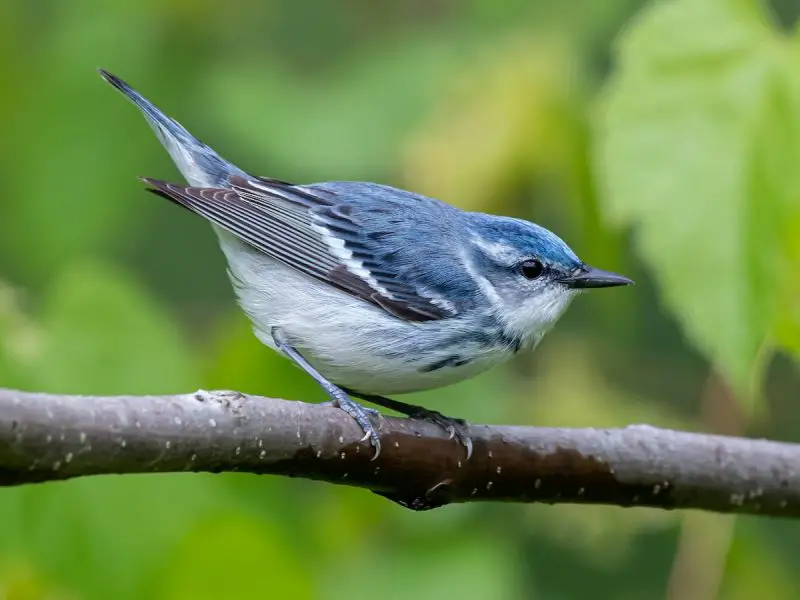
The Cerulean Warbler is a small, delicate species measuring 4.3 inches in length with a wingspan of about 7.5 inches. Breeding males are especially beautiful, with sky-blue upperparts, white underparts, and a necklace of dark streaks across the chest. Females are greenish-blue with pale yellow undersides, making them less conspicuous but still elegant.
This species feeds primarily on insects such as beetles, caterpillars, and flies, foraging high in the canopy where it can be difficult to spot. Its rapid, buzzy song often alerts birders to its presence before it is seen. Because they stay in the treetops, glimpses are often brief but rewarding.
In Texas, Cerulean Warblers are rare migrants, mostly observed in spring. They favor mature deciduous forests and wooded river corridors during migration stopovers. Their scarcity and canopy preference make sightings in the state highly prized among birdwatchers.
Cape May Warbler (Setophaga tigrina)
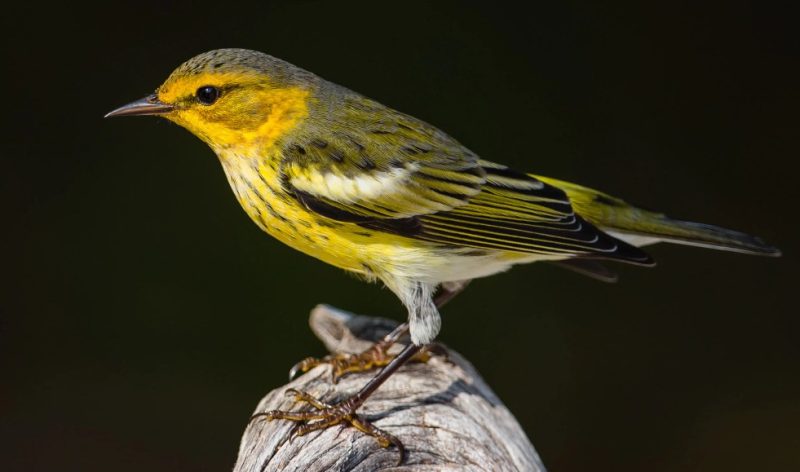
The Cape May Warbler is a medium-sized warbler, measuring 4.7 to 5.1 inches with a wingspan close to 8 inches. Breeding males are very distinctive, with a chestnut cheek patch, yellow underparts streaked with black, and a bold yellow-and-black patterned back. Females and nonbreeding birds are duller, showing more olive and yellowish tones.
Feeding behavior is flexible; while insects make up most of their diet, they are also known to consume nectar and berries during migration. They forage actively in the canopy, probing among needles and leaves for food. Their thin, high-pitched song is less musical than many other warblers, but their plumage makes up for it.
In Texas, Cape May Warblers are uncommon migrants, with most records occurring in spring and fall. They are more frequently spotted along the Gulf Coast, where many migrants stop after long flights across the Gulf of Mexico. Observers often find them in mixed warbler flocks in wooded habitats.
Magnolia Warbler (Setophaga magnolia)
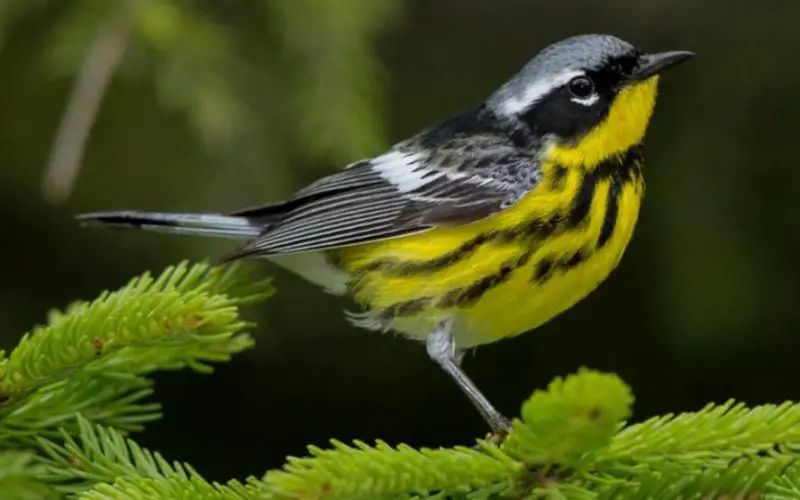
The Magnolia Warbler is a small bird measuring 4.3 to 5.1 inches long with a wingspan of about 7 inches. Breeding males are striking, with black masks, bright yellow underparts, and bold black streaks down the sides. Females and immatures are less vibrant but still show the characteristic yellow belly and contrasting plumage.
This species forages low to mid-level in trees and shrubs, often flicking its tail to reveal white tail patches. It primarily eats insects, especially caterpillars, and is often seen actively moving through dense vegetation. Their rich, sweet song and striking plumage make them a favorite among birdwatchers.
In Texas, Magnolia Warblers are regular migrants during spring and fall. They are typically found in woodlands, thickets, and forest edges. During fall migration, they can sometimes be numerous along the Gulf Coast, where they mix with other warblers resting after their journey.
Myrtle Warbler (Setophaga coronata coronata)
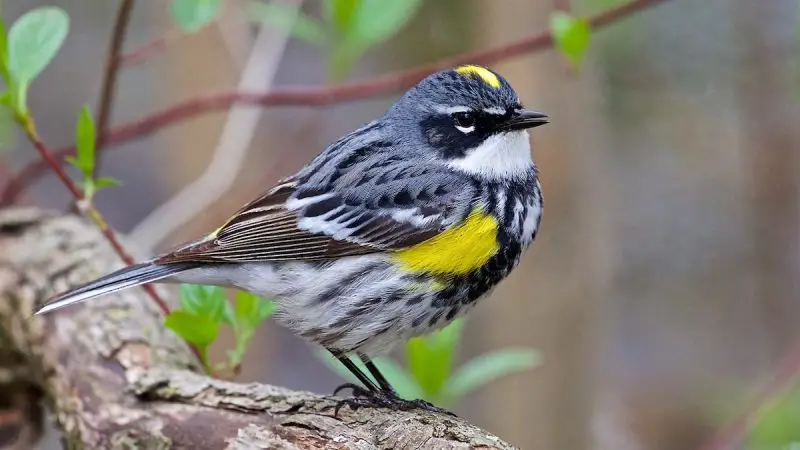
The Myrtle Warbler is a subspecies of the Yellow-rumped Warbler, measuring 5 to 6 inches in length with a wingspan of about 9 inches. It is recognized by its bright yellow rump, white throat, and black-streaked gray plumage. The contrasting white eyebrow helps distinguish it from the Audubon’s Warbler, which has a yellow throat instead.
Like other Yellow-rumped Warblers, the Myrtle subspecies has a diverse diet that includes insects, berries, and seeds. They are especially well known for feeding on waxy berries, such as those of bayberry and juniper, allowing them to winter farther north than most warblers. Their sharp “check” calls are a familiar sound in winter habitats.
In Texas, Myrtle Warblers are common winter residents and migrants, especially in the eastern and central parts of the state. They occupy open woodlands, parks, and even suburban neighborhoods, making them one of the most frequently observed warblers in Texas during the colder months.
Audubon’s Warbler (Setophaga coronata auduboni)
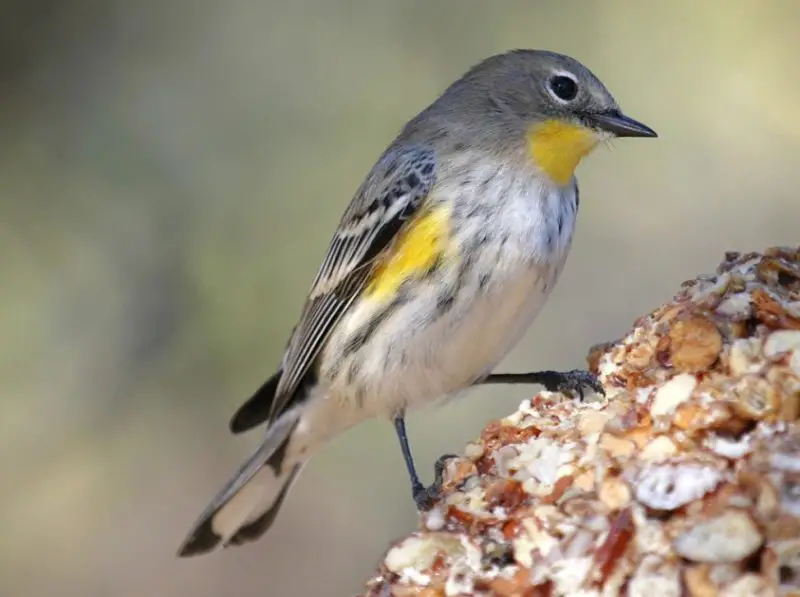
The Audubon’s Warbler is the western subspecies of the Yellow-rumped Warbler, measuring 5 to 6 inches long with a wingspan of 9 to 10 inches. It is distinguished from the Myrtle Warbler by its yellow throat, gray upperparts, and bold white wing patches. Males in breeding plumage are especially striking, while females and immatures appear duller but still show the characteristic yellow rump and sides.
This warbler has a varied diet, feeding on insects during warmer months and switching to berries, seeds, and waxy fruits in winter. They are agile foragers, catching insects midair or gleaning them from foliage, while in colder months they gather in flocks to forage on juniper and bayberry. Their sharp “chip” notes and varied songs make them a vocal presence.
In Texas, Audubon’s Warblers are mainly seen in the western and mountainous regions, particularly in migration and winter. They prefer open woodlands, pine forests, and scrubby habitats. Though not as widespread in Texas as the Myrtle Warbler, they remain a familiar wintering warbler in the right habitat.
Black-throated Gray Warbler (Setophaga nigrescens)
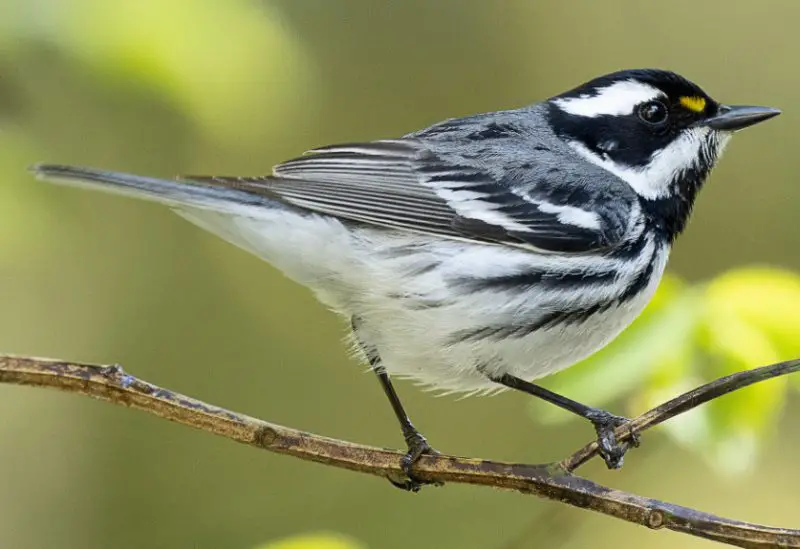
The Black-throated Gray Warbler is a small warbler about 4.7 to 5.1 inches in length with a wingspan of 7.5 inches. It is recognized by its gray body, bold black-and-white facial pattern, black throat, and yellow spot in front of the eye. The combination of crisp streaks and subdued tones makes it one of the more easily identifiable western warblers.
This species feeds mainly on insects and spiders, gleaning them from leaves and branches while moving steadily through trees. Unlike some more active warblers, it often forages in a deliberate manner, pausing to inspect leaves closely. Its buzzy, high-pitched song is a useful clue for birders during migration.
In Texas, Black-throated Gray Warblers are uncommon but regular migrants, with most records occurring in the western part of the state. They favor dry woodlands, juniper scrub, and forest edges during migration stopovers. Their subtle but sharp plumage pattern makes them a rewarding find for observant birdwatchers.
Townsend’s Warbler (Setophaga townsendi)
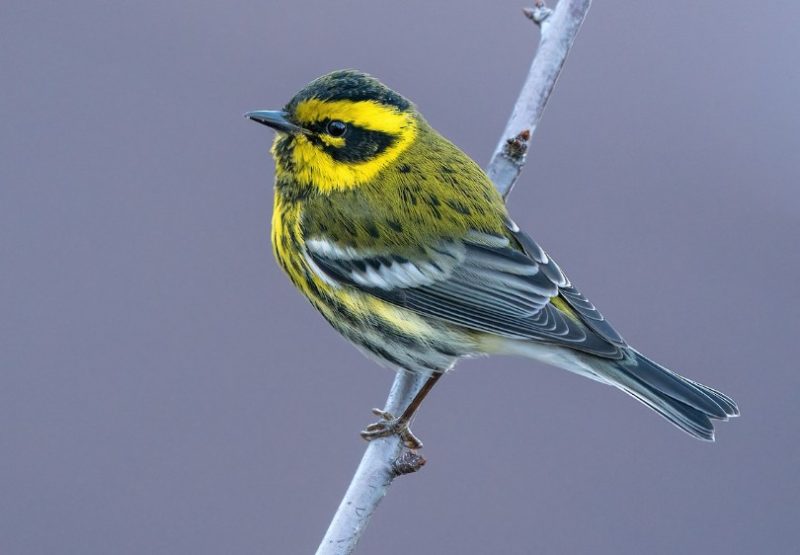
Townsend’s Warbler is a medium-sized warbler, measuring 4.7 to 5.1 inches long with a wingspan of about 7.5 inches. Breeding males are highly distinctive with a bright yellow face, bold black mask, and black streaks on the flanks. Females and immatures are duller but still show the same facial pattern and streaking.
Active and agile, Townsend’s Warblers forage for insects and spiders in conifers and mixed forests, often moving high in the canopy. They also hover and sally outward to catch flying insects. Their high, thin song is less musical than some warblers but still distinctive to experienced birders.
In Texas, Townsend’s Warblers are seen during migration, with most sightings along the western and Gulf Coast regions. They frequent wooded habitats, including pine stands and mixed forests, during their stopovers. Though not abundant, they are considered one of the more regular western migrants in the state.
Hermit Warbler (Setophaga occidentalis)
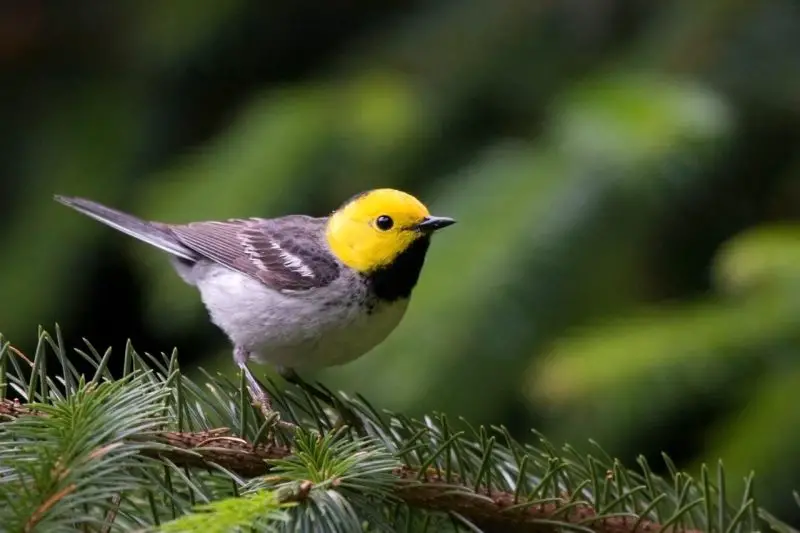
The Hermit Warbler is a small, elegant warbler about 4.7 to 5 inches in length with a wingspan of 7 to 8 inches. Breeding males are unmistakable with their bright yellow head, black throat, and gray body, while females and immatures are duller with less distinct markings. Their clean, refined plumage sets them apart from other warblers.
They primarily feed on insects and other small arthropods, gleaning them from leaves and branches, often in the upper canopy of coniferous forests. Unlike more restless warblers, Hermit Warblers forage in a slower, deliberate manner. Their soft, buzzy song carries through the forest but can be difficult to distinguish from related species.
In Texas, Hermit Warblers are considered rare migrants, mostly observed in the western regions of the state. They tend to appear in pine or mixed forests during migration stopovers. Because of their scarcity and preference for higher elevations, sightings in Texas are particularly prized among birdwatchers.
Yellow-throated Warbler (Setophaga dominica)
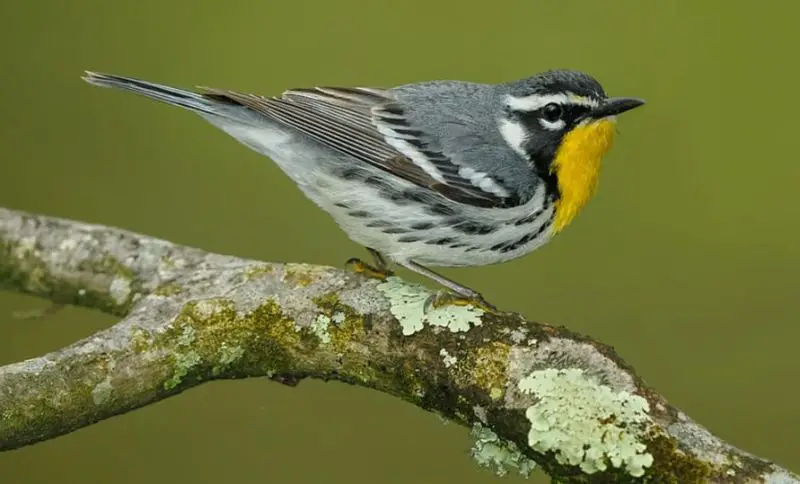
The Yellow-throated Warbler is a striking bird, measuring 5.1 to 5.5 inches long with a wingspan around 8 inches. It is identified by its bright yellow throat and chest, contrasting black facial stripes, gray upperparts, and white underparts. Its long bill and clean pattern make it one of the more distinctive warblers in the region.
This species feeds on insects, spiders, and small invertebrates, often foraging methodically along branches and probing into bark crevices. They are agile climbers, sometimes resembling nuthatches as they move along trunks and limbs. Their sweet, clear song is often one of the earliest warbler songs heard in spring.
In Texas, Yellow-throated Warblers are regular breeders in the eastern Pineywoods and bottomland forests. They are also seen during migration across much of the state. Their preference for pine forests and riparian woodlands makes them a familiar species in suitable habitats, especially in East Texas.
Golden-cheeked Warbler (Setophaga chrysoparia)
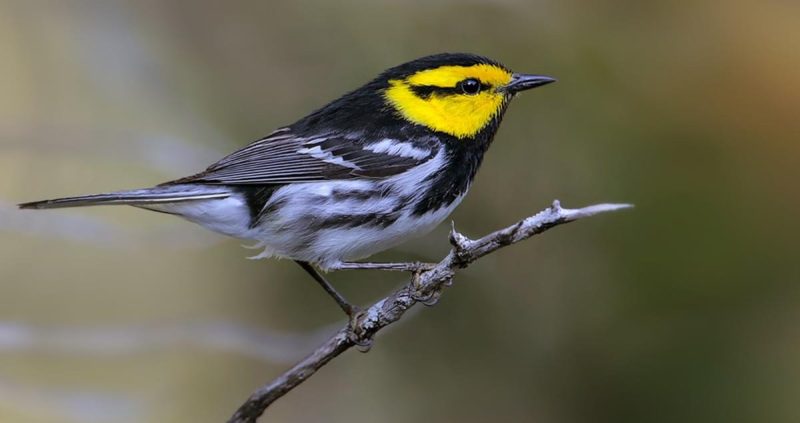
The Golden-cheeked Warbler is a small, striking warbler about 4.7 to 5.1 inches in length with a wingspan of 7 inches. Males display vivid black and white streaked backs, bright yellow cheeks, and a jet-black throat, while females are paler with grayish backs and yellowish cheeks. This species is unique as it is endemic to Texas, found only in the mixed oak-juniper forests of the Texas Hill Country.
Golden-cheeked Warblers feed primarily on insects and spiders, gleaning prey from leaves and bark. They are highly active foragers, often moving through mid-level to upper branches of oak and juniper trees. Their distinctive buzzy song and sharp calls help alert observers to their presence, though they can be elusive due to their dense habitat.
In Texas, Golden-cheeked Warblers are primarily found in breeding season between March and July. They prefer mature juniper-oak woodlands with dense canopy cover and are considered an endangered species. Birdwatchers often need patience and quiet to spot this highly localized and precious species.
Kentucky Warbler (Geothlypis formosa)
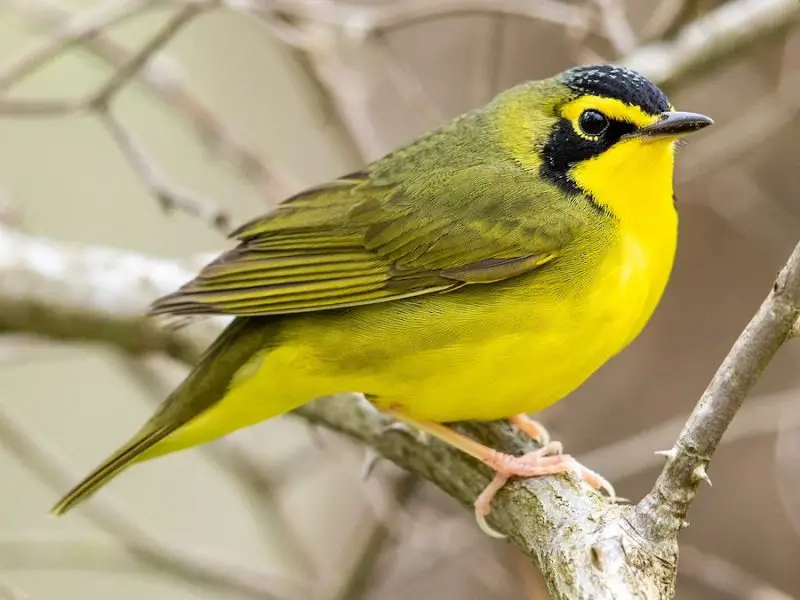
The Kentucky Warbler is a medium-sized, ground-dwelling warbler measuring 4.7 to 5 inches long with a wingspan of 7 inches. It is recognized by its olive-green upperparts, bright yellow underparts, and bold black “mask” extending from the eyes across the cheeks. Females and males are similar in appearance, with subtle differences in brightness.
This warbler forages primarily on the forest floor, flipping leaves and probing the soil for insects, spiders, and small invertebrates. Its skulking behavior and preference for dense understory make it more often heard than seen. The song is a loud, clear series of repeated notes, which often betrays its presence in thickets.
In Texas, Kentucky Warblers breed in moist deciduous forests in the eastern part of the state. They are also observed during migration in similar woodland habitats. Their preference for dense, leafy understory makes them a secretive but rewarding species for birdwatchers exploring eastern Texas forests.
Hooded Warbler (Setophaga citrina)
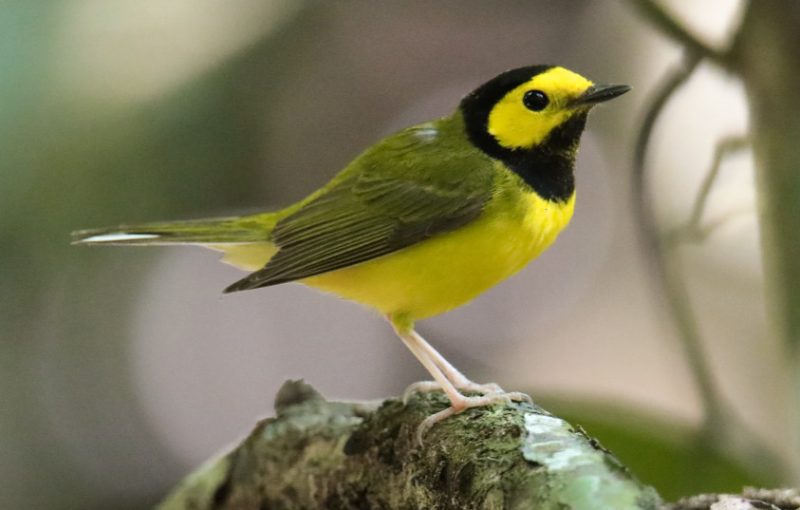
The Hooded Warbler is a small warbler about 4.3 to 5 inches long with a wingspan of 7 inches. Breeding males are easily recognized by their bright yellow face and underparts, contrasted with a bold black “hood” covering the head and throat. Females are olive-green above with yellow underparts and lack the prominent black hood.
Hooded Warblers forage in low shrubs and understory vegetation, actively gleaning insects, caterpillars, and spiders. They are agile and can move quickly through dense thickets, often revealing themselves with their clear, ringing song. Tail-flicking is a characteristic behavior while foraging.
In Texas, Hooded Warblers are primarily found during the breeding season in eastern woodlands, particularly in riparian forests and mixed deciduous habitats. They are also common migrants in spring and fall, favoring dense understory where they can hide yet remain audible through their distinctive song.
Prothonotary Warbler (Protonotaria citrea)
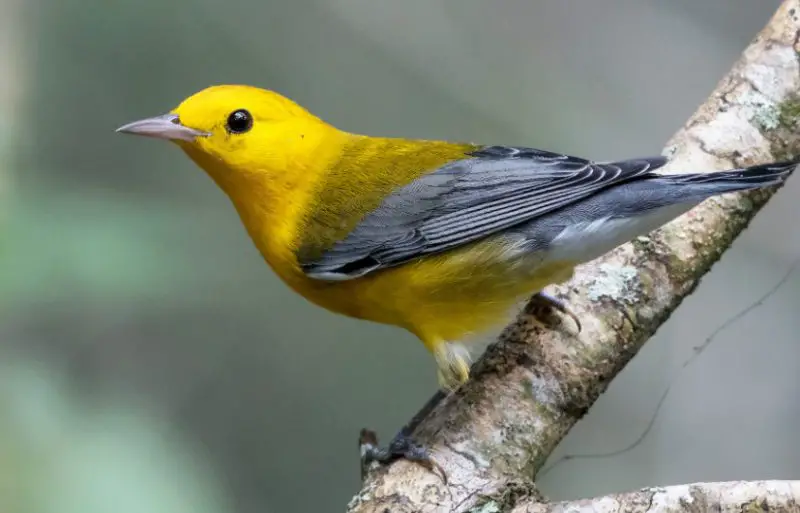
The Prothonotary Warbler is a medium-sized warbler, measuring about 5 to 5.5 inches long with a wingspan of 7.5 inches. Males are vivid yellow below with bright blue-gray upperparts and olive-green wings. Females are slightly duller, but still retain the golden-yellow underparts. Their striking coloration makes them highly visible in wooded wetland habitats.
This species specializes in foraging near water, gleaning insects, spiders, and small crustaceans from branches overhanging streams and swamps. They are cavity nesters, often using old woodpecker holes or nest boxes in flooded forests. Their loud, ringing song is a hallmark of swampy forests in spring.
In Texas, Prothonotary Warblers breed in eastern wetlands and floodplain forests, particularly along slow-moving rivers and streams. They are also common migrants along the Gulf Coast. Their dependence on riparian habitats makes them a species of interest for wetland conservation.
Worm-eating Warbler (Helmitheros vermivorum)
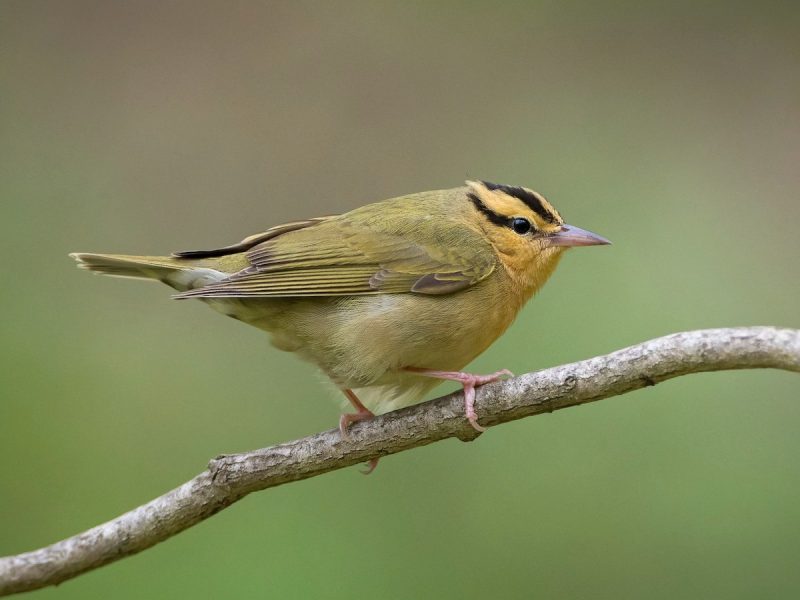
The Worm-eating Warbler is a small, secretive warbler measuring 4.3 to 5 inches in length with a wingspan of about 7 inches. It has warm brown upperparts, pale underparts with faint streaking, and bold black stripes on the head with a central pale crown stripe. Both sexes appear similar, with subtle differences in brightness.
This warbler forages primarily on the forest floor and low vegetation, flipping leaves to find insects, spiders, and larvae. It is named for its habit of eating caterpillars and other “worms.” Its soft, low-pitched song is often heard before the bird is seen, as it tends to remain hidden in dense leaf litter.
In Texas, Worm-eating Warblers breed in mature, deciduous forests in the eastern part of the state. They are also observed during migration in woodlands and forested areas. Due to their secretive behavior and preference for leaf-litter habitats, they are more often detected by song than by sight.
Louisiana Waterthrush (Parkesia motacilla)
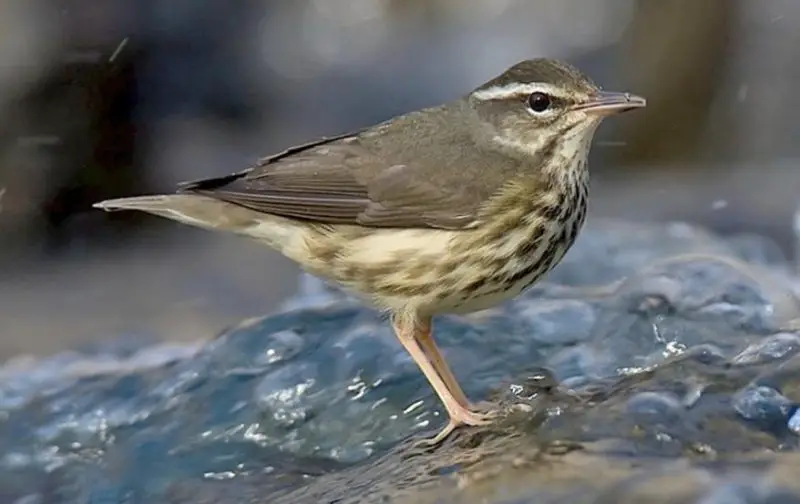
The Louisiana Waterthrush is a medium-sized warbler measuring 5 to 5.5 inches in length with a wingspan of 8 to 9 inches. It is recognized by its brown upperparts, white underparts heavily streaked with brown, and bold white eyebrow stripe. Both sexes look similar, though males are slightly brighter during the breeding season.
This species is strongly associated with streams and rivers, where it forages along rocky edges and shallow water. It feeds on aquatic insects, small crustaceans, and other invertebrates, often bobbing its tail as it searches for prey. Their loud, ringing song is a familiar sound along Texas waterways during migration and breeding.
In Texas, Louisiana Waterthrushes are mainly migrants and occasional breeders in the eastern part of the state. They prefer clear, fast-flowing streams with forested banks, making riparian corridors the best places to observe them. Their dependence on aquatic habitats makes them relatively localized compared to other warblers.
Northern Waterthrush (Parkesia noveboracensis)
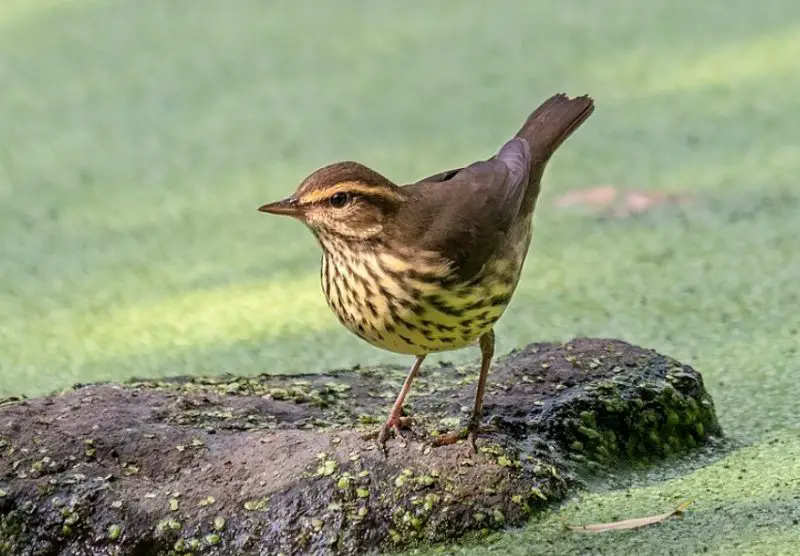
The Northern Waterthrush is similar in size to the Louisiana Waterthrush, measuring 5 to 5.5 inches long with a wingspan of around 8 inches. It has brown upperparts, heavily streaked pale underparts, and a long, bold white eyebrow stripe that distinguishes it from other waterthrush species. Its slender, slightly downcurved bill is adapted for probing in leaf litter.
This warbler forages on the ground along forested wetlands, puddles, and stream edges, feeding on insects, spiders, and small aquatic prey. They are active, constantly hopping and bobbing their tails while inspecting the substrate for food. Their sharp, high-pitched song is a good way to locate them in dense vegetation.
In Texas, Northern Waterthrushes are seen primarily during spring and fall migration, often in moist forests and along floodplain edges. They are widespread in eastern Texas, especially in riparian zones and lowland woodlands, making them a regular sight for birders in suitable habitats.
Ovenbird (Seiurus aurocapilla)
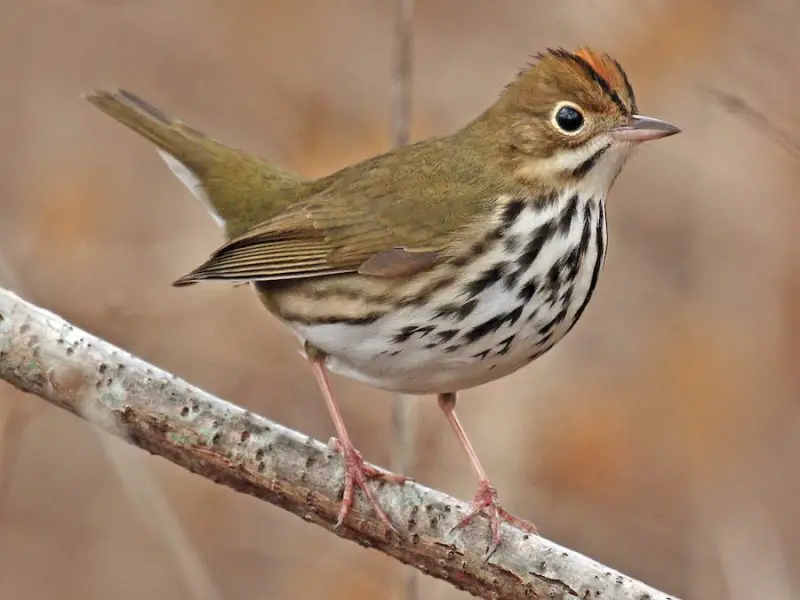
The Ovenbird is a small warbler about 4.7 to 5 inches long with a wingspan of 7.5 inches. It has olive-brown upperparts, white underparts with bold black streaks, and an orange crown bordered by black. Both sexes are similar, though males may appear slightly brighter during breeding. Its name comes from the dome-shaped ground nest it constructs, resembling a small oven.
Ovenbirds forage on the forest floor, flipping leaves to uncover insects, spiders, and larvae. They are relatively secretive but have a loud, ringing “teacher-teacher-teacher” song that carries through dense forests. Their behavior includes walking or running rather than hopping, which is unusual for warblers.
In Texas, Ovenbirds are primarily migrants, stopping over in woodlands and forested parks during spring and fall. Their preference for mature forests with dense leaf litter makes them a unique species to observe compared to canopy-dwelling warblers.
Swainson’s Warbler (Limnothlypis swainsonii)
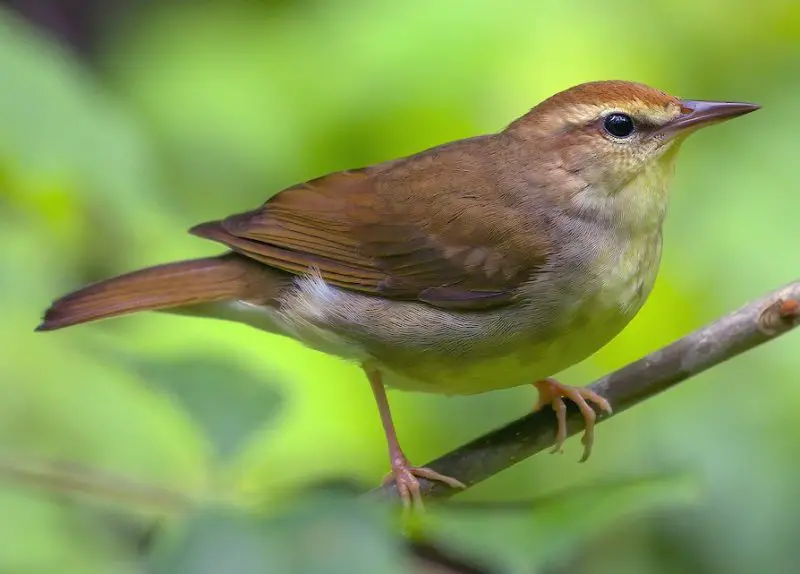
Swainson’s Warbler is a medium-sized, secretive warbler measuring 4.7 to 5.1 inches long with a wingspan of 7 to 7.5 inches. It has olive-brown upperparts, pale underparts with faint streaks, and a distinctive white throat. Both sexes look similar, with subtle variations in brightness.
This warbler is strongly associated with dense, swampy understory and thick tangles of vegetation. It forages close to the ground, feeding on insects, spiders, and larvae in leaf litter. Their high-pitched, short song is often the first indication of their presence, as they are notoriously difficult to spot.
In Texas, Swainson’s Warblers are rare but can be found in eastern forests and swampy habitats, particularly in spring and fall migration. They prefer mature bottomland forests with dense undergrowth, making them a challenge even for experienced birders.
Common Yellowthroat (Geothlypis trichas)
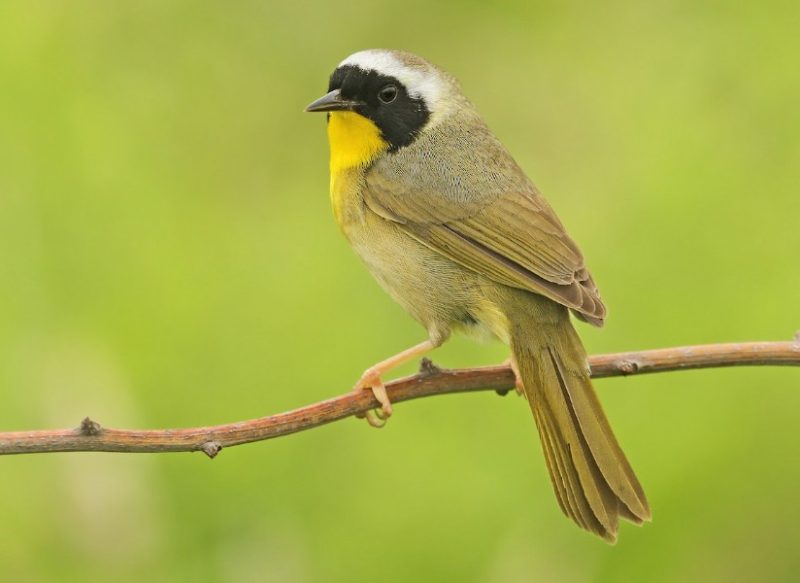
The Common Yellowthroat is a small warbler measuring 4.3 to 5 inches in length with a wingspan of about 7 inches. Males are easily recognized by their bright yellow underparts and black facial mask bordered with white. Females and immature birds are duller, lacking the black mask but still showing yellow throats and underparts.
This species forages actively in dense vegetation, including marshes, wetlands, and shrubby areas, feeding on insects, spiders, and small invertebrates. They are often seen hopping among stems and leaves, with constant tail flicking. Their distinctive “wichity-wichity-wichity” song is a hallmark of wetland habitats during migration and breeding.
In Texas, Common Yellowthroats are widespread, breeding in marshes and wet meadows in eastern and central parts of the state. They are also common migrants throughout the state, favoring dense, low vegetation where they can remain partially hidden while foraging.
MacGillivray’s Warbler (Geothlypis tolmiei)
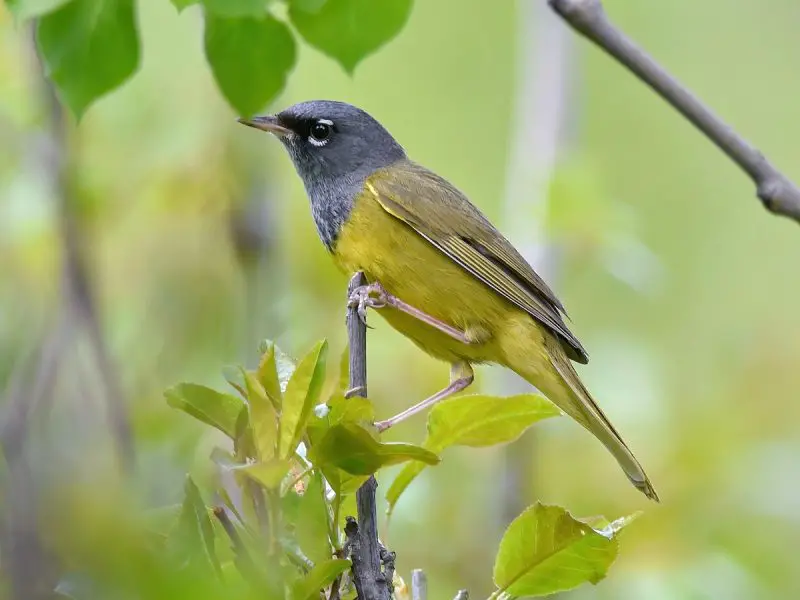
The MacGillivray’s Warbler is a medium-sized, secretive warbler measuring 4.7 to 5 inches in length with a wingspan of about 7 inches. It has olive-green upperparts, yellow underparts, and a dark gray hood extending from the face down the throat, giving it a subtle but distinctive appearance. Females are similar but slightly duller, with less contrast in the hood.
This species forages in dense shrubs and low trees, feeding on insects, spiders, and caterpillars. It is often heard before seen, as its song—a series of soft, buzzy notes—resonates from thickets. Its habit of staying near the ground and moving stealthily through brush makes it a challenge to spot.
In Texas, MacGillivray’s Warblers are uncommon migrants, mostly seen in the western and northern parts of the state during spring and fall. They prefer wooded slopes, shrubby canyons, and riparian thickets, often blending seamlessly into their surroundings until detected by song.
Mourning Warbler (Geothlypis philadelphia)
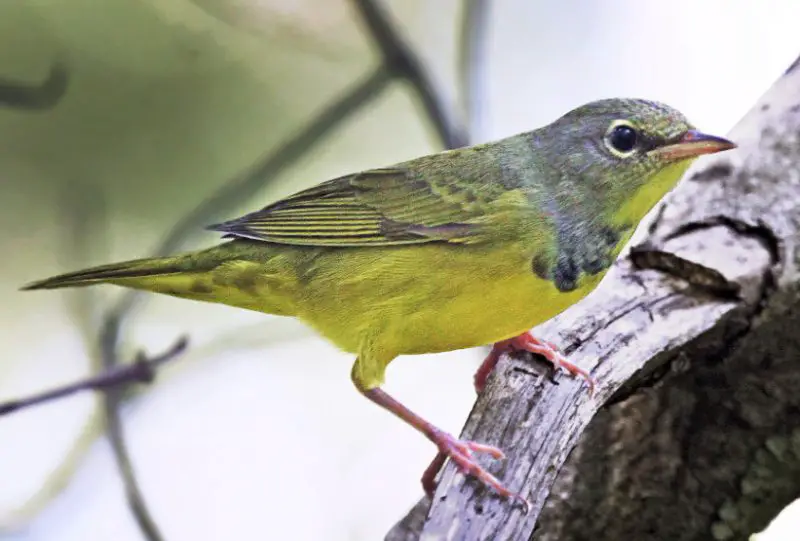
The Mourning Warbler is a small, understated warbler, measuring 4.7 inches long with a wingspan of about 7 inches. Males are gray above with a black patch on the throat and chest, yellow underparts, and olive wings and back. Females are paler with less pronounced throat markings, making them more subtle in appearance.
This species feeds primarily on insects and other invertebrates, foraging low in shrubs and on the forest floor. They are secretive, often skulking in dense understory and leaf litter, and are more often detected by their thin, descending song than by sight.
In Texas, Mourning Warblers are seen mainly during spring and fall migration. They inhabit dense woodlands, thickets, and forest edges. Their elusive behavior and preference for dense cover make them a challenging species for birders to observe.
Connecticut Warbler (Oporornis agilis)
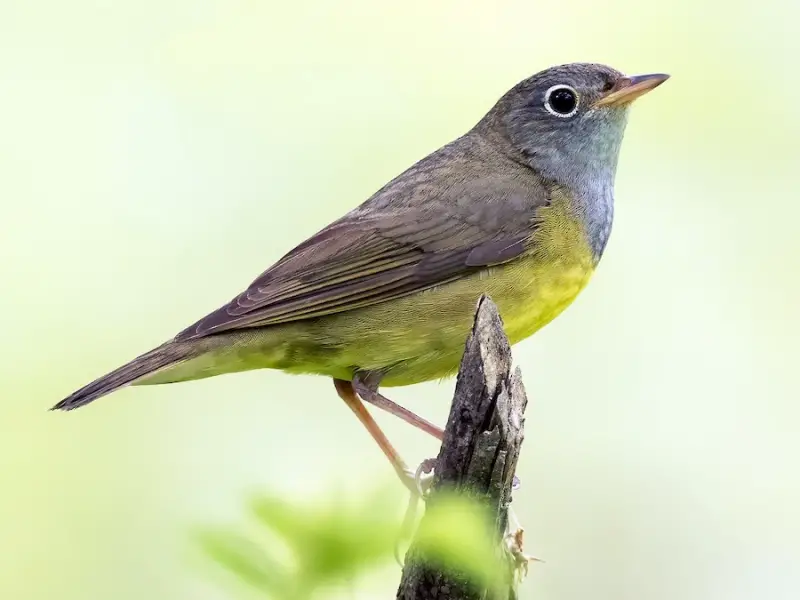
The Connecticut Warbler is a medium-sized warbler, about 4.7 to 5 inches long with a wingspan of 7 inches. Males have gray upperparts, a striking black throat, yellow underparts, and a subtle white eye-ring. Females and immatures are slightly duller with less pronounced throat markings.
They forage in dense understory, feeding on insects, spiders, and other small invertebrates. Their habit of staying near the ground and skulking through leaf litter makes them more often heard than seen. Their song is a clear, musical series of rising and falling notes that can carry through thick brush.
In Texas, Connecticut Warblers are rare migrants, most often observed in spring and fall. They prefer dense thickets, brushy riverbanks, and forested edges, making sightings highly prized among birdwatchers.
Canada Warbler (Cardellina canadensis)
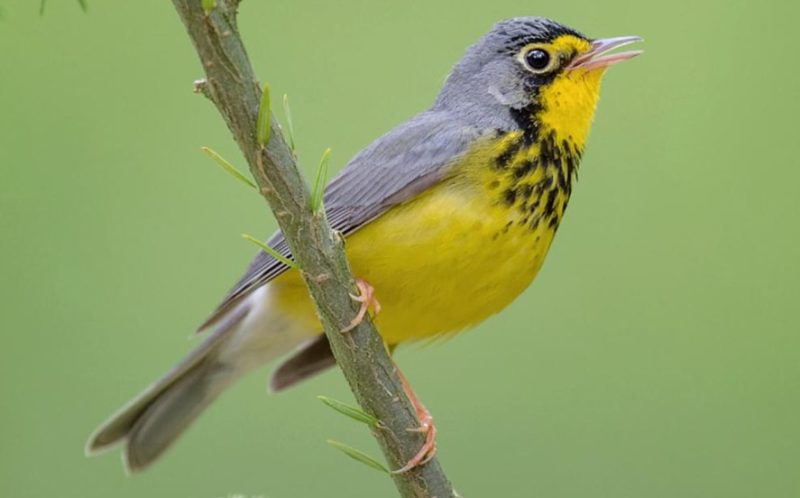
The Canada Warbler is a small, striking warbler measuring 4.7 to 5 inches long with a wingspan of about 7 inches. Males have slate-gray upperparts, bright yellow underparts, and bold black necklace-like streaks across the chest. Females are slightly duller but retain the yellow belly and gray back.
This species forages actively in dense, moist forests and along streams, feeding on insects, spiders, and other invertebrates. They move quickly through understory shrubs and low branches, often flicking their tail while foraging. Their soft, clear song is a series of musical notes, often delivered from concealed locations.
In Texas, Canada Warblers are uncommon migrants, seen mainly during spring and fall. They favor damp forests, riparian thickets, and shaded woodland areas, making them a special find for observant birders traveling through the state.
Wilson’s Warbler (Cardellina pusilla)
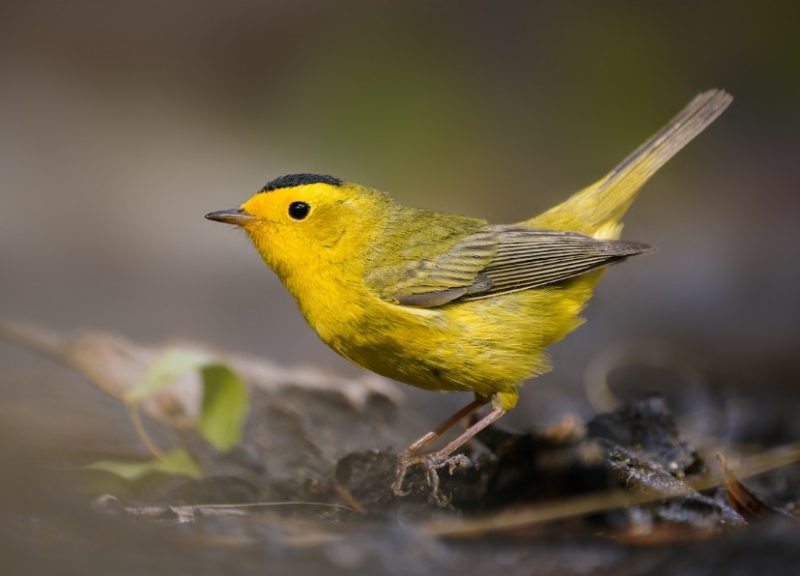
Wilson’s Warbler is a small, energetic warbler about 4.3 to 4.7 inches in length with a wingspan of 7 inches. Males are bright yellow below with olive-green upperparts and a distinctive black cap. Females and immature birds are duller with less conspicuous black caps.
They forage actively in low shrubs and forest edges, feeding on insects, spiders, and caterpillars. Wilson’s Warblers are constantly moving, hopping through foliage and often flicking their tails. Their sweet, high-pitched “wil-son, wil-son” song is characteristic of spring and fall migration.
In Texas, Wilson’s Warblers are common migrants during spring and fall, frequenting woodland edges, thickets, and brushy areas. They prefer low vegetation, making them easier to observe than many canopy-dwelling warblers.
Red-faced Warbler (Cardellina rubrifrons)
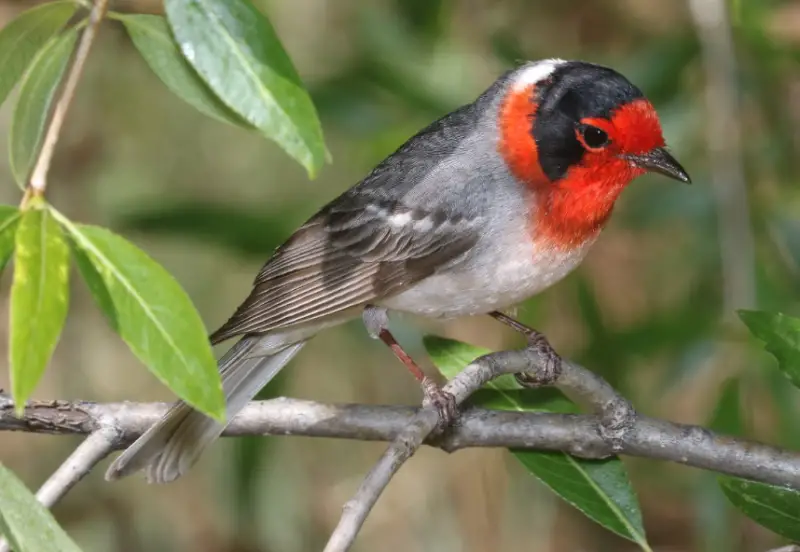
The Red-faced Warbler is a small warbler, measuring about 4.7 to 5 inches in length with a wingspan of approximately 7 inches. It is instantly recognizable by its bright red face and throat, contrasting sharply with gray upperparts, white underparts, and black wings. Females and immature birds are paler, with less intense red facial coloration, but still show the characteristic gray and white patterning.
This species forages actively in pine-oak forests, mixed coniferous woodlands, and mountain canyons, primarily feeding on insects, spiders, and other small invertebrates. It gleans prey from leaves, branches, and occasionally from the forest floor. Its song is a thin, high-pitched series of notes that can carry through dense woodland, often giving away its presence before it is seen.
In Texas, Red-faced Warblers are rare migrants or occasional breeders in the western mountainous regions, especially in the Chisos and Davis Mountains. They prefer high-elevation forests with dense understory, making sightings both challenging and highly prized for birdwatchers exploring west Texas habitats.
Rufous-capped Warbler (Basileuterus rufifrons)
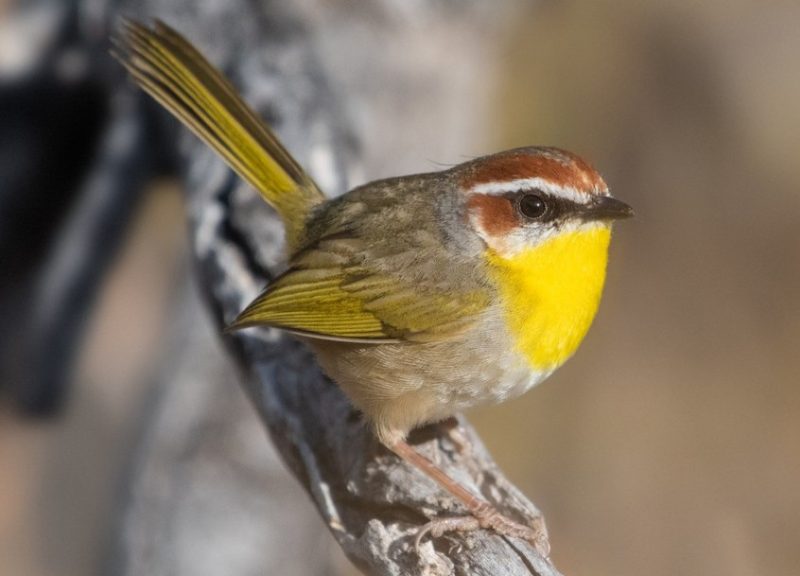
The Rufous-capped Warbler is a small, striking warbler about 4.3 to 4.7 inches long with a wingspan of 7 inches. It is easily identified by its bright rufous crown, olive-green back, and yellowish underparts, along with a bold white supercilium that contrasts with the darker face. Females are slightly duller but retain the characteristic cap and facial markings.
This species forages actively in dense undergrowth, feeding primarily on insects, spiders, and other small invertebrates. It is highly active, moving through shrubs and low trees while flicking its tail. Its song is a rapid series of high-pitched notes, often delivered from concealed locations within dense brush.
In Texas, Rufous-capped Warblers are primarily seen in the southernmost parts of the state, particularly near the Rio Grande Valley and along the southern border. They prefer dense thorn scrub, riparian thickets, and subtropical brush habitats, making them a localized and exciting species for birders in these regions.
FAQs about Warblers in Texas
What are the most common warblers in Texas?
The most common warblers in Texas include species such as the Yellow-rumped Warbler, Orange-crowned Warbler, Common Yellowthroat, and American Redstart. These birds are frequently observed in wooded areas, parks, and near rivers or streams, especially during migration seasons when they move between breeding and wintering grounds. Their vibrant plumage and distinctive songs make them relatively easy to spot for birdwatchers who know where to look.
When is the best time to see warblers in Texas?
The ideal time to observe warblers in Texas is during the spring and fall migration periods, which typically occur from March to May and August to October. During these months, large numbers of warblers pass through the state, and peak sightings often happen in early April for spring migration and late September for fall migration. Observing them during these periods increases the chances of seeing a wide variety of species in one area.
Where are warblers usually found in Texas?
Warblers are most commonly found in forests, woodlands, shrubby areas, and riparian zones along rivers and streams. Coastal regions, wildlife refuges, and parklands also provide excellent stopover points during migration. These environments offer abundant food resources and shelter, which are essential for their survival as they travel long distances.
How can you identify different warbler species in Texas?
Identifying warbler species in Texas relies on careful observation of plumage, color patterns, size, and song. For instance, the Yellow Warbler is easily recognized by its bright yellow body with reddish streaks, while the Black-and-white Warbler displays bold stripes and a distinctive habit of climbing tree trunks. Paying attention to these visual and auditory cues can greatly enhance the accuracy of identification for birdwatchers.
Do warblers breed in Texas?
Some warbler species do breed in Texas, primarily in the eastern and central wooded regions. Species such as the Yellow-throated Warbler and Black-and-white Warbler establish nesting territories and raise their young in these areas. However, many other species are transient migrants that only stop in Texas briefly during spring and fall, using the state as a passageway to their breeding or wintering grounds.
What are the feeding habits of warblers in Texas?
Warblers primarily feed on insects, spiders, and other small invertebrates, which they often glean from leaves, branches, and bark. During migration, some species supplement their diet with berries and small fruits to fuel their long journeys. Their foraging behavior is usually active and acrobatic, allowing them to exploit different layers of vegetation effectively.
Are warblers endangered or threatened in Texas?
While most warbler species in Texas are not currently considered endangered, some populations are vulnerable due to habitat loss, climate change, and human activities. Conservation of forests, wetlands, and other natural habitats is critical to maintaining healthy populations. Birdwatchers and conservationists often participate in monitoring programs to track warbler numbers and ensure these colorful migrants continue to thrive in the state.

